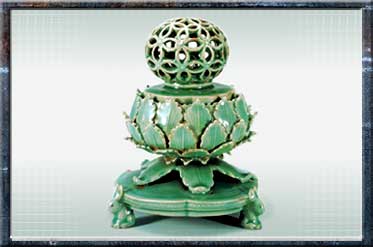
![]()

The production of Koryo celadon was centered in Kangjin,
an area in South Cholla province. At first influenced by the style and
technique of Chinese celadons, the Kangjin kilns gradually began making
wares which weremore distinctively Korean. By King Yejong's reign(1105-1122),
the Chinese elements almost completely disappeared. This period up to
the beginning of the12th century is generally regarded as the early
stage in the development of celadon when plain, or undecorated, celadon
flourished.
During King Injong's reign(l 123-1146), Koryo celadon became more refined
and elegant, including the beautiful jade green hue of its glaze. The
surface decoration reached its peak during King Uijong's reign(1147-1170)
withthe introduction and refinement of the inlay technique. A wide range
of celadon was made during this time, including undecorated, inlaid,
iron-painted, copper-painted, gold-painted, iron-glazed, and black-glazed
celadons andceladon tiles. In addition, some white wares were also produced.
The quality as well as the different types of vessels produced remained
virtually unchangeduntil the Mongol invasions in the early 13th century.
This phase between 1123 and 1230 is designated as the middle stage in
the development of celadon.
After the Mongol invasion, Koryo celadon entered into a phase of rapid
decline. Therefore, the period from the Mongol invasion in 1231 to the
end of the Koryo dynasty represents the latestage in Koryo celadon production.
With the revival of gold-painted and copper-painted celadons and the
introduction of new shapes and decorative schemes, a brief period of
upheaval flourished around the year 1284. But thiswas to be only a temporary
burst of activity.
Perhaps the most distinctive characteristic of Koryo celadon is the
way in which its form, decoration, and glaze harmonizes perfectly withnature.
Its fluid and graceful contours, its lively shapes, its bright yet refined
jade color all participate in creating an interesting and balanced whole
rather than rigid perfection. Moreover, the inlaid and copperpainted
decoration on celadon demonstrates both technical and pictorial creativity.
Thelyrical motifs of the inlaid design harmonize with the vessel itself,
while the red tone of the copper accents brightens without destroying
the overall subdued color scheme.